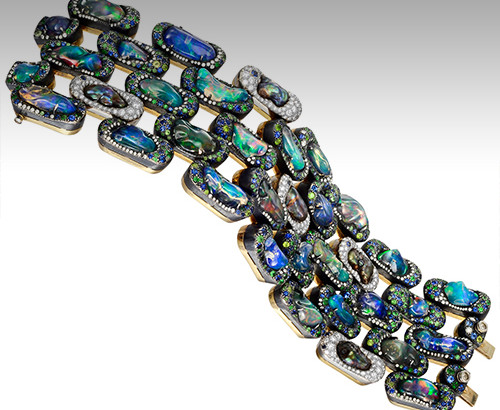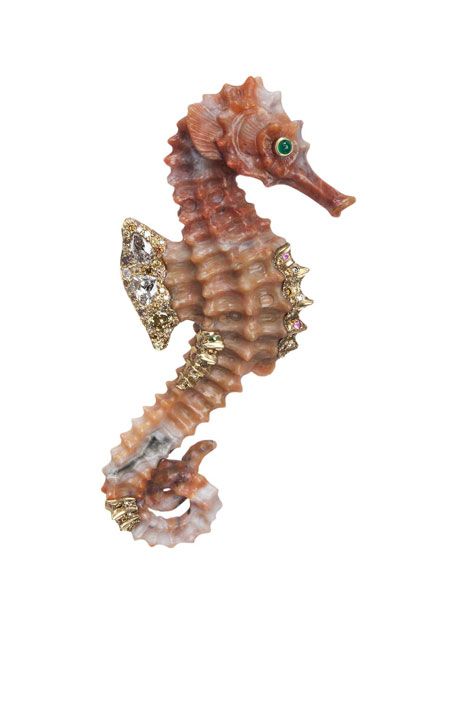Based in New York, Nicholas Varney Jewels is famous for richly colored, high luxury bijoux. The Nicholas Varney style is dynamically design-driven and rich in strangely beautiful combinations of gems, minerals, shells, and natural pearls from all kinds of bivalves such as quahog clams. Then there are also organics such as pinkish conch pearls, along with other mystically-colored and luminous gem materials.
Nicholas Varney the designer is a colorful contemplative whose enthusiasm for haute luxe bijoux, visual delight and beautiful materials from all of nature is infectious. I interviewed Varney and his associate Claibourne Poindexter, who is a jewelry historian and head of Product Development at Nicholas Varney Jewels.
While discussing Varney’s intensely rich design aesthetic, Poindexter relates, “Nicholas has an eye for color unlike any person I have ever met. He knows what wild color combinations will work before he ever gets to physically pair them together. It is a gift I have yet to find in anyone else.”
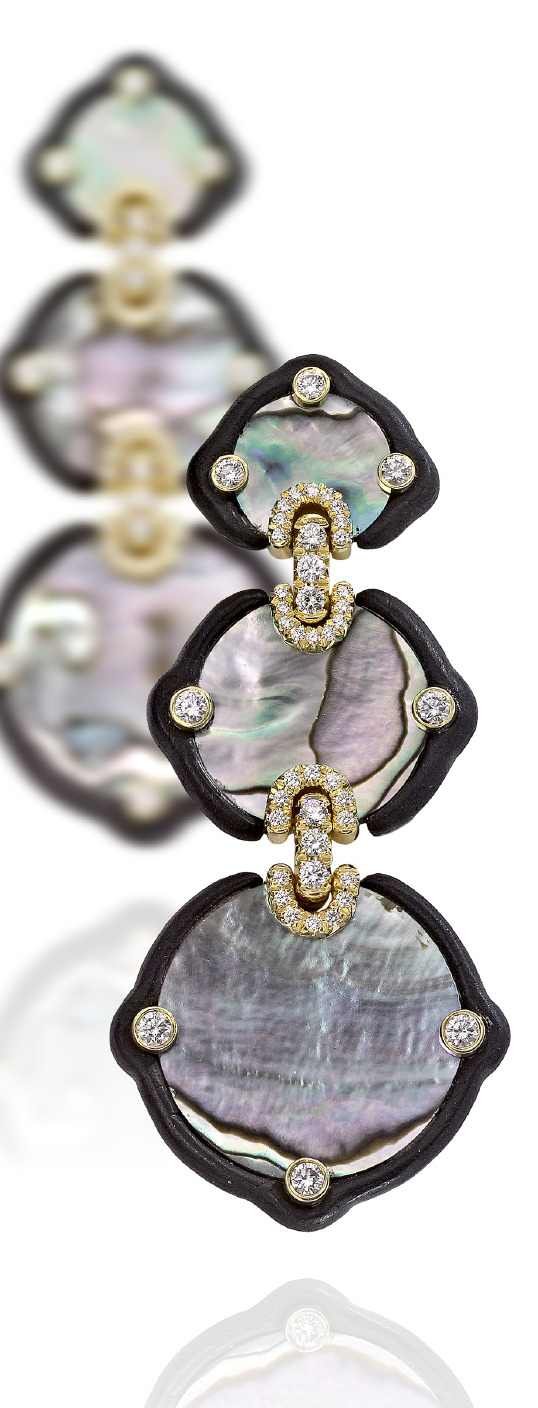
Known for selecting richly colored seashells in his jewelry, Nicholas Varney’s “Abalone Slice” earrings are a triple treat of 18K gold, ebony, diamonds and iridescent abalone shell. Photo Credit: courtesy of Nicholas Varney
A key element that contributes to Varney’s triumphantly colorful and sophisticated jewelry is his penchant for rendering kaleidoscopically colorful jewels in drawings– and then hunting for gems, minerals, woods, shells and pearls to make his drawings come to bejeweled life.
According to Poindexter, “Nicholas buys gems in a most personal fashion.” For example, Nicholas buys whatever he sees that he loves (for the most part). At one show it could be hard stones for carving projects and at the next show it could be some fantastic parcel of melee that has struck a chord with him.” This fact, in Poindexter’s opinion, “is key to what makes the finished product so successful and unlike that created by any other designer.”
That’s as graceful an introduction as I can imagine. Now for the interview with Nicholas Varney.
KR: I have the impression that your primary input mode is visual and that you always drew a lot as a child. Did you study art history or go to art school?
NV: Yes. I was a studio art major and art history minor in college. As a child I was always drawing and I actually designed some fabrics for my mother’s wall covering company (Carleton V. Ltd.) when I was around eleven.
KR: Do you have any childhood gem and jewelry memories to share? How old were you when jewelry and gem materials started catching your eye?
NV: I was 11 when I first fell in love with jewelry and jewelry design. It was during a vacation in Gstaad, Switzerland when my father and I went out to pick out a piece of jewelry as a present for my mother. We ended up as a result purchasing a beautiful cabochon sapphire ring in the shop of Eric Bertrand, who at the time was a Geneva-based jeweler.
I was immediately captivated by this adventure. I remember how proud I felt that my father could afford to buy such a special present as a token of love. I was immediately hooked when I saw the loving environment engendered by my father giving that jewel as a gift to my mother.
KR: Along those lines, is there a piece of jewelry from your past that you remember noticing, liking or being fascinated by?
NV: That sapphire ring has always had a special place in my life because of the aforementioned experience. My mother also had some wonderful jewels by Marguerite Stix.
Marguerite was a sculptor first and foremost but also a woman who created wonderful jewels made with shells collected by herself as well as her husband. The third piece that I also have always very much liked is a Paul Flato compact I purchased from Christie’s in the mid 1990s at auction. Made with two color gold, it came from the collection of Claudette Colbert and in rose gold on the top her facsimile signature “Claudette” is spelled out in rose gold. It is a fun piece and reflects the glamour of that time.
KR: Did you grow up around people who wore high luxury jewelry? If so, what kind of pieces/designers did they wear that caught your eye?
NV: Because of the circles my parents ran in, many adults I grew up around wore great pieces of jewelry but I did not necessarily care or notice who created the pieces they wore. I really just noticed the sparkle and the color and the glamour of it all.
KR: Have you done formal studies in gemology or are you self-taught? Did you ever study jewelry making or work at the bench?
NV: I am a GG [graduate gemologist]. When I first started out, I did all of my own wax casts as well as a little bit of bench work…the results of such efforts were not good enough.
KR: Please describe the first piece of jewelry that you designed and had fabricated. How old were you then? Please specify the materials you used, and any other important details.
NV: I’ve been designing jewels since I was 11 through drawings and such but the first pieces I actually fabricated were in college. They were all composed of silver and consisted of predominantly cufflinks I could wear myself.
The first piece of jewelry I created when I opened shop was the birch wood log bangle bracelet (which I actually did create the wax cast for myself). This became a favorite staple piece of jewelry for several New York City women, including my mother as well as the late Evelyn Lauder. She and her husband Leonard were so generous to me and I was honored to create some wonderful things for her.
KR: Please can you define your vision of high luxury jewelry? What differentiates high luxury jewelry different from fine jewelry? What is essential to HIGH LUXURY jewelry? For example it the creative effect(s) that the jewel achieves through design, quality of materials, use of materials, workmanship? What role does rarity of materials and cost of materials play?
NV: “High Luxury Jewelry” in my opinion is the 1% of overlap where creativity is allowed into the gem sphere. There are two distinct camps: gems and jewelry. The way I envision the two means that they have very little or next to nothing to do with one another on a most basic level.
High luxury jewelry designers make designs first and do not necessarily care intrinsically about the value of materials. Gem dealers, or people who make fine jewelry on the other hand, possess gems and create settings around a particular stone/stones to appeal to as many people as possible.
In other words, high luxury jewelry is starting with an idea for a design and finding the gemstones for that idea. This is versus taking a stone and building a design around it to make the piece all about that stone, with the intention to create a piece that will have mass appeal.
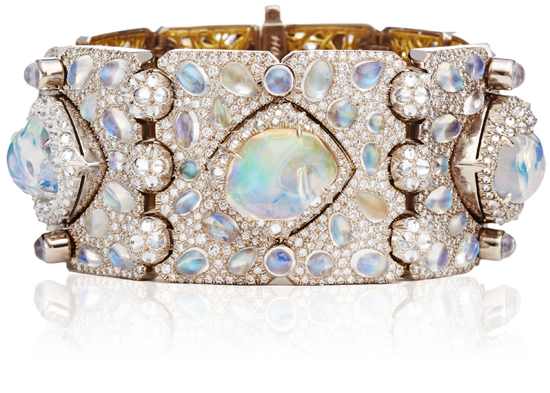
Dazzling with diamonds, this 18K gold Nicholas Varney bracelet shines with the milky yet multi-colored light of opals and luminous moonstones. Photo Credit: courtesy of Nicholas Varney
KR: Nicholas Varney jewelry designs embody fearlessly colorful combinations of pearls, gemstones, minerals, precious metals, shells, and of course, beautiful woods like cocobolo. Your designs create dramatic, hypnotically attractive effects that make people stare in wonder. To my mind, there is a strong emotional charge to your jewels. WHAT INSPIRES THE VIBRANCY of your designs? Is it emotion?
NV: Yes it is emotion. We always try to elicit an emotional reaction. Not from everyone all the time, but we try to trigger an emotion between that one special client and that one-of-a-kind piece of jewelry, which is always meaningful when those two things come together.
KR:What is your design imagination most heavily influenced by? The gems that you have to work with at any given time? Your travels? The seasons? Experiences in nature?
NV: I never really start with a particular stone in order to create a design. What I really try to go for is conflict and juxtaposition, and oftentimes nature is a background to the jewels I create.
Take for example a fantastic fire engine red, cushion cut Burmese Spinel that a client of mine had previously purchased. I ended up setting it for her in cocobolo wood with four bullet shaped diamonds that held the center stone in place. I had rendered this design beforehand and when I saw this stone, I knew it would work perfectly in the design I had already rendered. In my opinion, [the wood]makes everything about the piece of jewelry stand out more. You can see a spinel set in exotic wood so much more clearly than in a basic, boring gold setting. I am of course inspired by my travels and by nature, but my designs spring from so much more than that…
KR: Is everything you make one of a kind? Do you ever do limited editions?
NV: Most of the jewelry I create is one of a kind, but we also do limited runs of pieces. I have a bracelet made of cacholong that we have sold over the years and continue to sell to this day. I also have a pair of earrings called the “slice” earrings which we produce in limited quantity. Due to the abalone shell slices’ unique patterning, no one pair of these earclips is the same, although the silhouette remains consistent. In some instances, I may change a layout or a stone combination in order to make it one-of-a-kind.
Most of the pieces we do are one-of-a kind and simply cannot be replicated because many times the waxes are made to fit a stone of unique shape.

Gleaming with psychedelic, blue-green Paraiba tourmalines, diamonds and tsavorite garnets, this 18K gold mushroom ring embodies the full-bodied color and drama that is so characteristic of Nicholas Varney jewels. Found only in Brazil, Paraiba tourmalines are some of the world’s rarest and most expensive stones. Photo Credit: courtesy of Nicholas Varney
KR: What are your favorite gemstones and why? (Because your jewels are so richly colored, I realize this may be tough!)
NV: This is actually a pretty easy question for me. My favorites are peridot and natural pearls of all types, shapes, and sizes.
The majority of peridot that has been mined comes out of America and is mined by Native Americans in Arizona (although technically the best material comes from Burma), and the color is unlike anything else, gemstone-wise. I feel a special connection to it because for some reason the stone is so American to me (because of how and where it is mined in this day and age), and we of course are an American company. Natural pearls have always been so fascinating to me because of the fact that they are creations of mother nature, and no one is ever the same.
KR: Your jewels incorporate dramatic interpretations of nature motifs such as sea horses, mushrooms, etc. Is the natural world your chief inspiration? What are your chief inspirations?
NV: My chief inspiration is once again conflict and juxtaposition with nature as a driving force. I was a competitive baseball player in college who thought for a minute about professional baseball and ultimately decided to pursue a career as a jewelry designer instead.
KR: What year did you found Nicholas Varney jewels?
NV: I founded Nicholas Varney Jewels in 1996.
KR: How many employees in your company? Where are your jewels fabricated?
NV: The number of employees in the company is constantly changing because we work with so many different people. Almost all of the jewelry is manufactured in New York City, but on occasion I have pieces fabricated by jewelers in London and Paris.
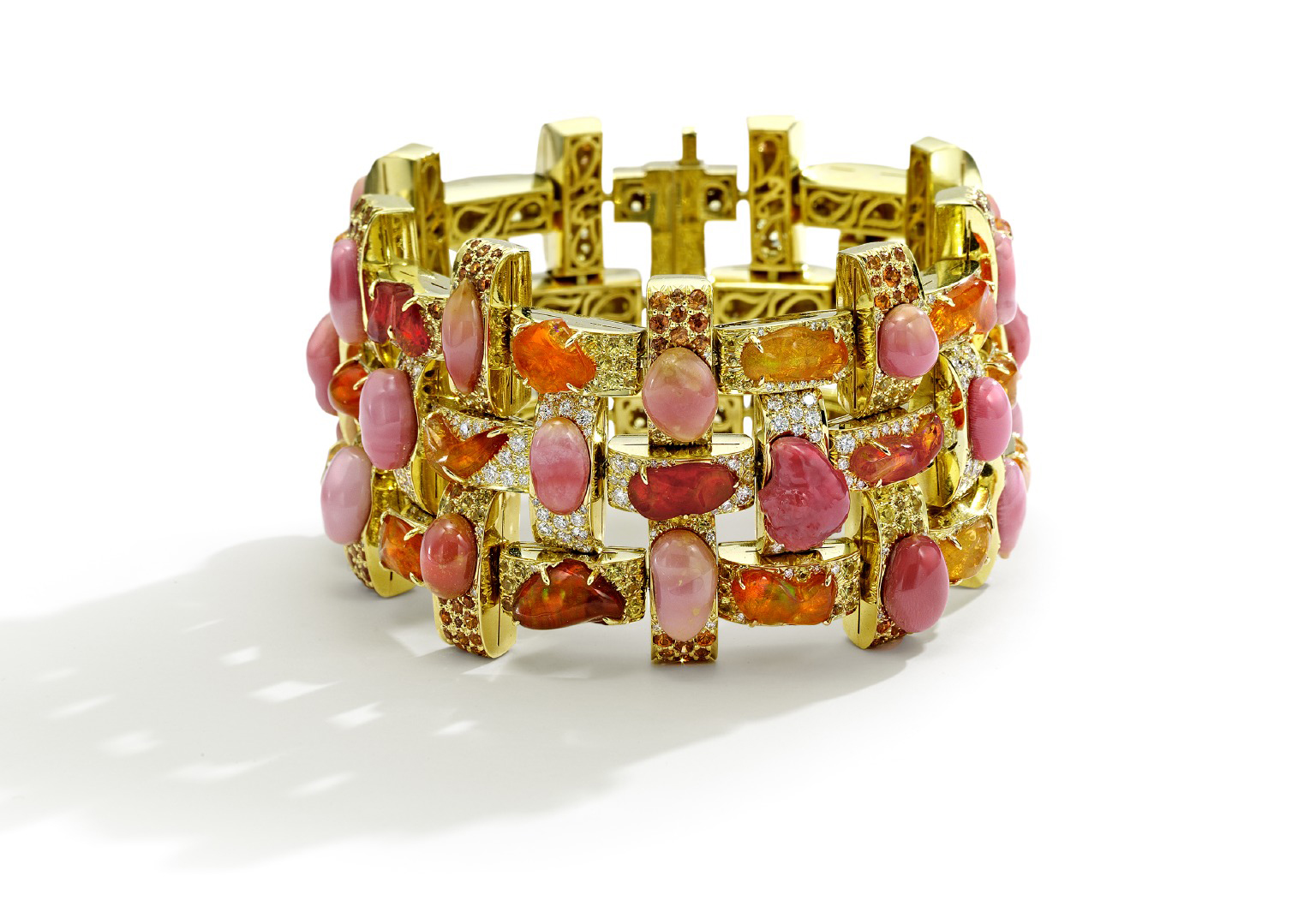
Glowing in rich sunset hues, this Nicholas Varney18K gold bracelet features luminous pink conch pearls, blazing orange fire opals, diamonds and yellow sapphires. Note the gracefully designed 18K gold grille on the underside. Photo Credit: courtesy of Nicholas Varney
KR: Please tell me about your position vis-a-vis jewelry history and how you work with your associate Claibourne Poindexter.
NV: Jewelry history is a highly under appreciated art form and endeavor. I am very lucky to have a great head of product development, Claibourne Poindexter. Claibourne happens to be an encyclopedia of jewelry knowledge. Claibourne and I often discuss and debate the importance of jewels from the past, including successes and failures in the field. I firmly believe that in order to make jewels that will be relevant not only now but in the future, one must always respect the past and refer to it for guidance, insight and inspiration.
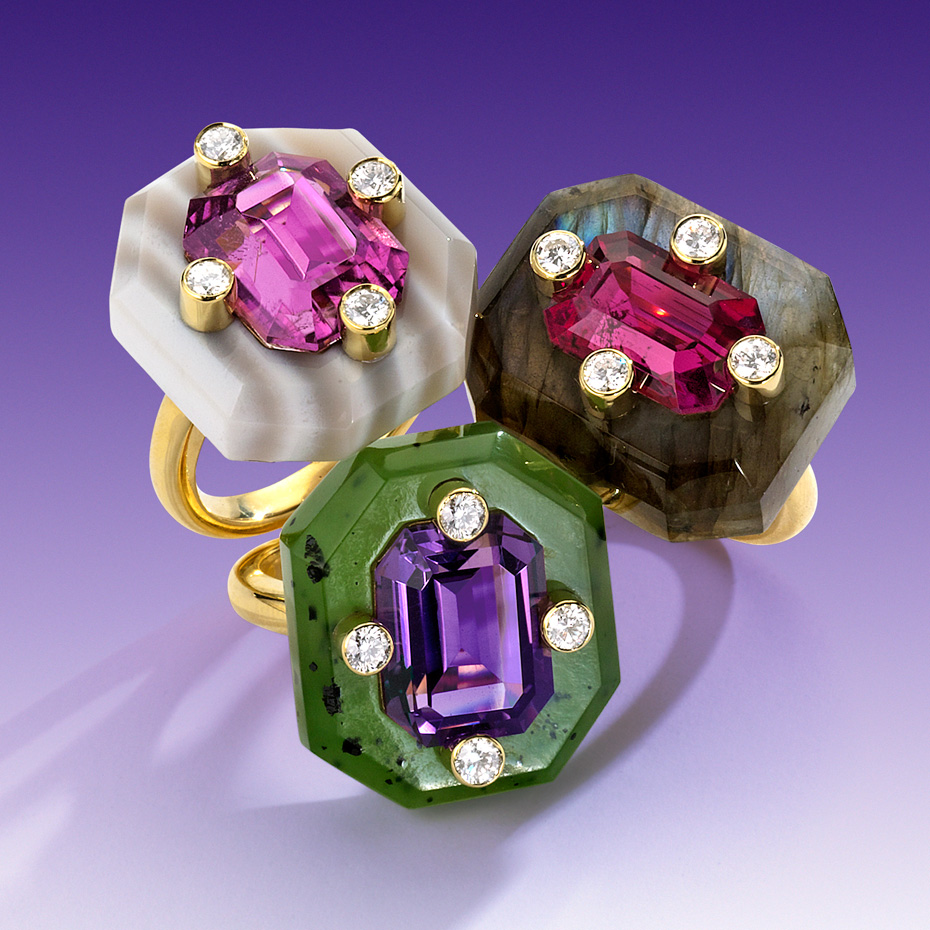
Nicholas Varney fearlessly juxtaposes vibrantly-colored gemstones with brightly-hued minerals in three rings. First, a carved labradorite, pink tourmaline and diamond ring. Second, a carved nephrite jade, amethyst and diamond ring. Third, a carved striped agate, California pink tourmaline and diamond ring. Photo Credit: courtesy of Nicholas Varney
KR: Finally, who are your favorite jewelry designers past and present, dead and alive?
NV: Jean Schlumberger, Marguerite Stix, and JAR.
Jean Schlumberger [who designed for Tiffany & Co. from 1956 until the late 1970s] was the first to really master the organic, free flowing nature of jewelry design and take it to a higher level. So many of his jewels, if you look closely, are clearly asymmetrical on a consistent basis and on purpose, and that is something I really am adamant about when designing…how to make pieces irregular in some fashion.
Slightly irregular designs are so much more intriguing for both the wearer and the people who come into contact with jewels. Schlumberger also loved the sea. My love of the sea has certainly made its way into my jewels, as well.
Marguerite Stix I admire simply because she loved shells and incorporated them into jewels much like the artist and sculptor she first and foremost was, and less like a jewelry designer. While not the first to use shells in jewelry by any means, Marguerite Stix did many things with them that no other designer or house had dared before.
JAR, is of course, JAR. The execution of design and incorporation of both stones and techniques of creating jewelry have set a bar for the way jewelry really should be made in the 21st century.
Editor’s Note: Nicholas Varney Jewels retail online at: Cayen Collection http://www.cayenjewelers.com and Betteridge http://www.betteridge.com. For more information, go to www.nicholasvarneyjewels.com

